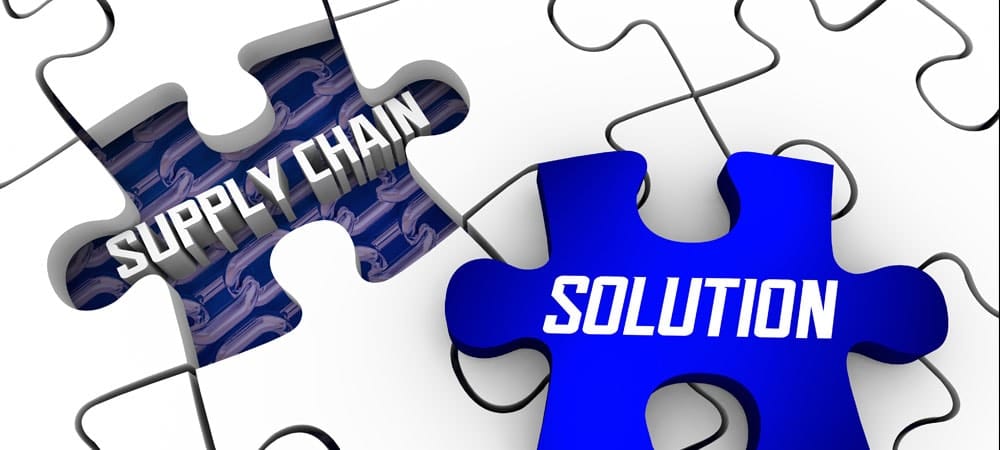Supply chain - the new confusion


Agility and intensive market observation are helpful. IT tools for refining the ERP system can also contain the negative effects. The field of activity and the framework conditions of supply chain management have changed fundamentally in the past two years. Figuratively speaking: A road race has become an obstacle course in rough terrain. Troubled times have arrived. As a result, the demands on SAP-supported supply chain management are also changing fundamentally. To stay with the metaphor, it is not primarily a matter of driving around the bend a little cleaner and faster when visibility is good. Instead, it is a matter of ensuring that you reach the finish line at all on unknown terrain and in bad weather.
Scarcity as a permanent condition
The initial conditions are well known; every company is affected in one way or another. It started with strict pandemic regulations in China's ports and manufacturing plants, continued with container ship congestion and drastically rising freight costs. In parallel, the shortage of semiconductors emerged, affecting the entire mechanical engineering industry in addition to the automotive industry. Paper and plastic packaging materials are in short supply throughout, partly due to another escalating factor - skyrocketing energy prices. Supposedly trivial events such as a stuck container ship in the Suez Canal further fueled the crisis. The war on European soil resulted in further shortages of products as diverse as automotive wiring harnesses and nails for wooden pallets.
In an Ifo survey conducted in March 2022, around 80 percent of the companies surveyed are affected by bottlenecks. The Kiel Institute for the World Economy (IfW) estimates that German industrial production in 2021 was twelve percent below the level it would have been without supply bottlenecks and material shortages. This corresponds to a value of 70 billion euros and two percent of German gross domestic product. Unfortunately, it cannot be assumed that the lever will be turned in this situation and that we will return to the (from today's perspective almost paradisiacal) conditions of the pre-pandemic period. Energy prices will in all likelihood remain high and the semiconductor crisis will keep us busy until at least 2024.
Procurement becomes a matter for the boss
In this situation, many manufacturing companies have switched to crisis mode. In design and development, machines are being reconsidered so that available microchips can be used. Procurement, for example of semiconductors, has been declared a matter for the boss or the board of directors, and for many supplier parts and raw materials, buyers are looking for secondary suppliers who are happy to be located locally instead of on other continents.
Under these circumstances, supply chain management software has a new role to play - or rather several new roles. One thing remains: Management's demand on supply chain experts to ensure a smooth and cost-optimized supply chain. But fulfilling this task has become much more difficult. It means squaring the circle: you have to forecast the unpredictable and reliably plan and execute the impossible.
What seems to be manageable in such an abstract way quickly becomes almost impossible when you get specific and describe the unforeseen: When it only becomes apparent at the start of a shift that the required materials have not been delivered just in time and the plan from the previous day's scheduling therefore does not work. When it only becomes clear in the morning how many employees are in quarantine. When customer call-offs are adjusted x times during the course of the day.
Flexibility costs
Then flexibility is required, but flexibility costs. It costs time in the form of setup and planning costs, it means higher logistics costs for smaller production quantities and more machine downtime due to short-term full load instead of smoothed production. So it's better to increase safety stock? Stock more intermediate and finished products? This also costs, and not only because of capital commitment and warehousing. Price changes - a big issue at the moment anyway - also have to be factored in, or the loss due to the perishability of materials.

First, the entire supply chain must be looked at even more closely. End-to-end ERP systems based on SAP are a good prerequisite for this. However, they should be supplemented and refined by SCM-specific tools such as GIB-Suite on ERP/ECC 6.0 or GIB-SCX on S/4 Hana. These tools increase transparency across the entire supply chain and create the prerequisite for quickly identifying irregularities. The user then has a kind of "bottleneck radar" at his disposal, on the basis of which he can react at an early stage and take targeted countermeasures.
More agility
The GIB software very specifically ensures transparency and speed. In other words, it promotes agility. It immediately warns of changes in customer requirements and simulates intralogistics processes to determine the best production sequence given capacities and material availability. It also allows you to jump directly from the order to the primary and secondary requirements to identify and resolve bottlenecks directly. And it ensures transparency at the machine in order to remain capable of action even in the last mile.
Transparency is desired as well as a data basis for all decision makers. In addition to transparency, the GIB tools also provide some very meaningful key figures that indicate the quality status of the supply chain and define exactly where action is needed in supply chain management. This ensures that everyone involved is looking at the same database in the SAP system and talking about the same things. Suppliers - even those without their own SAP system - can also be included in this information chain.
Farewell to globalization?
Apart from these currently important optimizations, fundamental questions also arise: Is it now time to adjust the supply chain strategy? For years, the trend was toward internationalization, and this also brought advantages. Now the disadvantages are becoming apparent and many a purchasing manager or supply chain manager will wish for the supposedly good old days before globalization, which he or she only knows from hearsay. Back then, you simply sent a truck to the supplier when parts were missing and were not dependent on what was happening in Chinese ports or shipping accidents in the Suez Canal.
Insourcing and nearshoring
The desire to reintegrate previously outsourced processes is understandable. Probably never before has the supply chain been so unstable and critical for so many companies. But are strategies like insourcing or near-shoring realistic? Can they be a real alternative from an economic perspective? The answer is complex. Short chains are more stable, it's true. But first, I think you have to be fair. If you want to sell globally, you shouldn't limit your sourcing to the nearest neighborhood. What if the example of customers in China and the USA sets a precedent? Then entire markets will collapse.
Moreover, wage differences, for example, cannot be explained away. And it might be difficult to buy microchips or special sensors in the neighborhood. Some supply chains are simply global, and if you add raw materials, that even applies to most supply chains. Economies of scale and core competencies also play a role. If a service provider produces, paints or finishes components for 50 or 200 customers, he can most likely do it both better and cheaper than each customer on his own. So we will have to live with complexity. There is no return to a pre-globalized economy. But every company is called upon to deal wisely with the fact of globalized supply chains and to see where risks can be reduced.
One measure could and should be: check where you buy locally instead of globally. In doing so, one should not only look at the price, which is then often likely to be higher. It is also worthwhile to put the type and manner of cooperation to the test. With a local supplier, cooperation can be structured differently than with suppliers on the other side of the globe. Perhaps the local supplier has an idea for optimizing the design? Or does he supply a complete module instead of various components? Physical proximity also creates other opportunities for cooperation.
Stabilize the supply chain
This means that supply chain optimization, which is often driven by necessity, should not only be about the distance to the supplier, but also about the type of relationship you maintain. And regardless of where the supplier is located - whether in Stuttgart or Shenzhen - you should bring transparency into the supply chain. Then, in the best case, you can plan according to demand, monitor promptly and, as far as supplier management is concerned, sit at the steering wheel instead of in the passenger seat. This stabilizes the supply chain.
What can also help: to make use of qualified service in the form of consulting. At ifm (previously GIB), consulting with the aim of "Continuous Improvement" is simply part of continuous customer care. Both sides learn from this: the customers through comprehensive market knowledge of the consultants who regularly "listen in" on numerous and very different companies, and the consultants through getting to know new and practical "use cases" for which solutions have to be found.
Good reasons for supply chain optimization: Apart from the disruptions of increasingly complex supply chains, there are other reasons for targeted and IT-supported supply chain optimization. Both the Supply Chain Act and the increasing consideration of sustainability factors demand a higher degree of transparency across the entire logistics and procurement process.
Stable supply chain ensures success
The ifm group of companies, which also includes GIB, is a good example of how a close look at the supply chain makes a lasting contribution to corporate success, especially in turbulent times. In the past financial year, the specialist for innovative automation technology was able to increase the previous year's sales by 21 percent and achieve a new sales record of around 1.16 billion euros. "The fact that we have come through the crisis so strengthened shows that our growth strategy with a diversified market and sector structure is successful in the long term"says Christoph von Rosenberg, CFO of the ifm Group, on the occasion of the publication of the business figures: "A stable supply chain despite disrupted supply chains worldwide also played a significant role in our success. In 96.4 percent of cases, we were thus able to realize delivery on the customer's desired date in 2021 as well."
Earnings (EBIT) of 10.6 percent (previous year 7.6 percent) also increased significantly compared to the previous year and reached a record level. These pleasing data and figures are certainly not exclusively attributable to the use of the GIB software tools developed in-house. But they will already have made a contribution.








